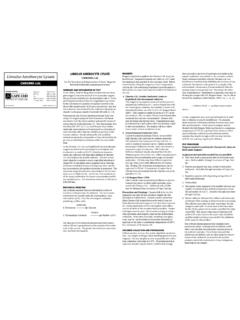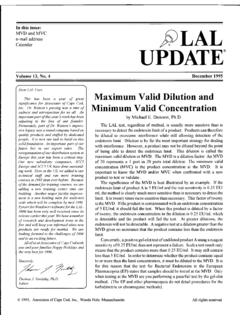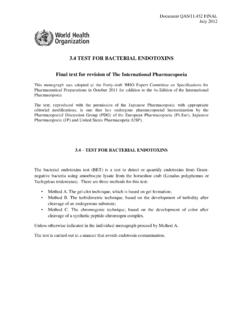Transcription of October, 2012 LALUpdate - Associates of Cape Cod, …
1 The New FDA Guidance for Industry Pyrogen and endotoxins Testing: Questions and Answers . October, 2012. LALU pdate volume 28, number 1. Letter From The Editor On June 29, 2012 FDA released the long awaited guidance document on pyrogen and endotoxin testing, almost exactly a year after the withdrawal of the former guidance documents (the 1987 Guideline on Validation of the Limulus Amebocyte Lysate Test as an End-Product Endotoxin Test For Human and Animal Parenteral Drugs, Biological Products and Medical Devices and the 1991 Interim Guidance for Human and Veterinary Drug Products and Biologicals: Kinetic LAL Techniques. It is interesting to note the broader scope of the new document. Unlike the withdrawn guidance documents, it includes pyrogen testing in the title and one of the questions addresses pyrogen testing and when it is appropriate to use this test.)
2 However, within that broader scope the question and answer (Q & A) document focuses on specific issues and does not claim to cover the breadth of endotoxin (or pyrogen) testing, as is made clear in the introduction to the document. In this article most of the text of the Q & A document is reproduced in italics and comments are provided after each section. Note that in the original Q & A references are given as footnotes at the bottom of each page. In this article they have been consolidated at the end of the text. Note that a number of citations are repeated several times. We would like to hear your comments on the new Q & A document. Please send them to With best wishes, Michael Dawson, , RAC. Corporate Headquarters UK Office European Office Associates of Cape Cod, Inc.
3 Associates of Cape Cod Int'l Inc. Pyroquant Diagnostik GmbH. 124 Bernard E. Saint Jean Drive, Deacon Park, Moorgate Road, Opelstrasse 14, East Falmouth, MA 02536 Knowsley, Liverpool L33 7RX D-64546 Morfelden-Walldorf, T (508) 540 3444 United Kingdom Germany F (508) 540 8680 T (44) 151-547-7444 T (49) 61 05-96 10 0. F (44) 151-547-7400 F (49) 61 05-96 10 15. LALU pdate volume 28, number 1 - October, 2012. Guidance for Industry Pyrogen and endotoxins Testing: Questions and Answers I. INTRODUCTION III. QUESTIONS AND ANSWERS. This guidance provides recommendations for biological product, drug, 1. How do I establish a sampling plan for in-process testing and device firms on FDA's current thinking concerning the testing recom- and finished product release?
4 Mendations and acceptance criteria in the United States Pharmacopeia (USP) Chapter <85> Bacterial endotoxins Test,2 USP Chapter The current good manufacturing practice (CGMP) regulations for finished pharmaceuticals and the medical device quality system regulations require <161> Transfusion and Infusion Assemblies and Similar Medical Devices, 3. development of controls that include scientifically sound and appropriate and the Association for the Advancement of Medical Instrumentation (AAMI). sampling ,9. ST72:2002/R2010, Bacterial endotoxins Test Methodologies, Routine Monitoring, and Alternatives to Batch Testing (AAMI ST72).4,5 These three Sampling plan information is addressed in AAMI ST72, but not USP.
5 Documents describe the fundamental principles of the gel clot, photometric, Chapter <85>. Firms should include a sampling plan as part of their and kinetic test methods, and recommend that appropriate components and application documentation. In the sampling plan, firms should consider finished products be tested for the presence of pyrogens and endotoxins . the potential for contamination in raw materials, in-process materials, and the finished product. Specifically, firms should take into account aspects This guidance does not cover the entire subject of pyrogen and endotoxins of the manufacturing design, including consistency of a manufacturing testing. Instead, it addresses those issues that may be subject to process, impact of in-process hold times, endotoxins removal steps, and misinterpretation and are not covered in compendial procedures or in finished product endotoxins specifications.
6 The sampling plan should be currently available guidance documents. You should already have a considered dynamic; firms should begin with maximum coverage and thorough understanding of these documents when using this guidance. adjust their sampling plans as they gain confidence in the prevention of FDA's guidance documents, including this guidance, do not establish legally endotoxins in their manufacturing processes. Firms should update their enforceable responsibilities. Instead, guidances describe the Agency's cur- regulatory filings when adjusting sampling plans. For drugs and biological rent thinking on a topic and should be viewed only as recommendations, products, in-process changes to sampling plans are annual reportable unless specific regulatory or statutory requirements are cited.
7 The use of For devices, a 30-day notice11 may be appropriate for in-process the word should in Agency guidances means that something is suggested changes to the sampling or recommended, but not required. Comment: The 1987 Guideline stated Sampling technique Comment: Note that the current revision of the ANSI/AAMI selected and the number of units to be tested should be standard ST72 is 2011, not 2002/R2010. While the principles based on the manufacturing procedures and the batch size. of the two versions of ST72 are generally consistent, the new A minimum of three units, representing the beginning, middle, revision contains additional information and it is recommended and end, should be tested from a lot.
8 The new wording puts that the current version be used. more emphasis on the justification of an appropriate sampling technique. This might result in the need for an increased level II. BACKGROUND of testing until an appropriate history of testing has been docu- mented. There is no mention in the response to Question 1 of For more than 30 years, FDA has accepted the use of a Limulus Amoebo- cyte Lysate (LAL) test for endotoxins in lieu of the rabbit pyrogens test. In a sampling from the beginning, middle, and end of a production November 4, 1977, Federal Register notice (42 FR 57749), FDA described run, though there is in the response to Question 4. conditions for using LAL as a finished product By 1983, FDA indicated in guidance that an LAL test could be used as a finished product test Note that in reference 7 the ANSI/AAMI standard ST72 is mixed for endotoxins .
9 These tests were described in a series of draft and final in with the reference for USP chapter <161>. The number of the guidance documents. The last guidance document, Guideline on Validation standard is missing. In addition, as stated in the first comment of the Limulus Amebocyte Lysate Test as an End-Product Endotoxin Test on section I. INTRODUCTION, the current revision of the standard for Human and Animal Parenteral Drugs, Biological Products, and Medical is 2011, not 2002/R2010. Devices, was published in 1987 (the 1987 Guidance). FDA has found that the published USP and AAMI documents describing 2. When is retesting appropriate? methods and calculation of pyrogen and endotoxins testing limits7 provide industry with appropriate information.
10 We also note the continued devel- When conflicting results occur within a test run, firms should consult USP. opment of USP Chapters <85> and <161> and FDA guidance documents. Chapter <85>, Gel Clot Limits Test, Interpretation, for guidance on repeat The Agency has withdrawn the 1987 Guidance because it no longer testing. As specified in Chapter <85>, if the test failure occurred at less reflects the Agency's current thinking on the topic. However, because than the maximum valid dilution (MVD), the test should be repeated using the compendial chapters and standards do not address certain regulatory a greater dilution not exceeding the MVD. A record of this failure should perspectives, FDA is providing supplemental information in this guidance be included in the laboratory results.












